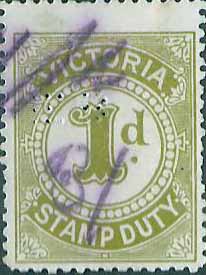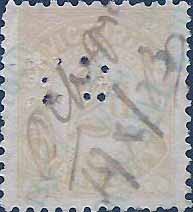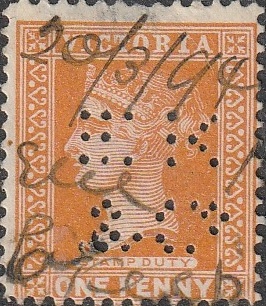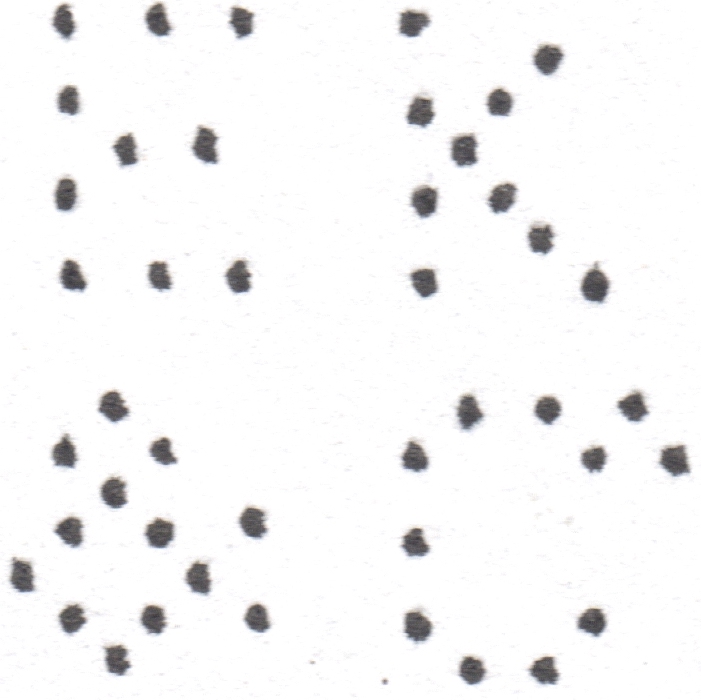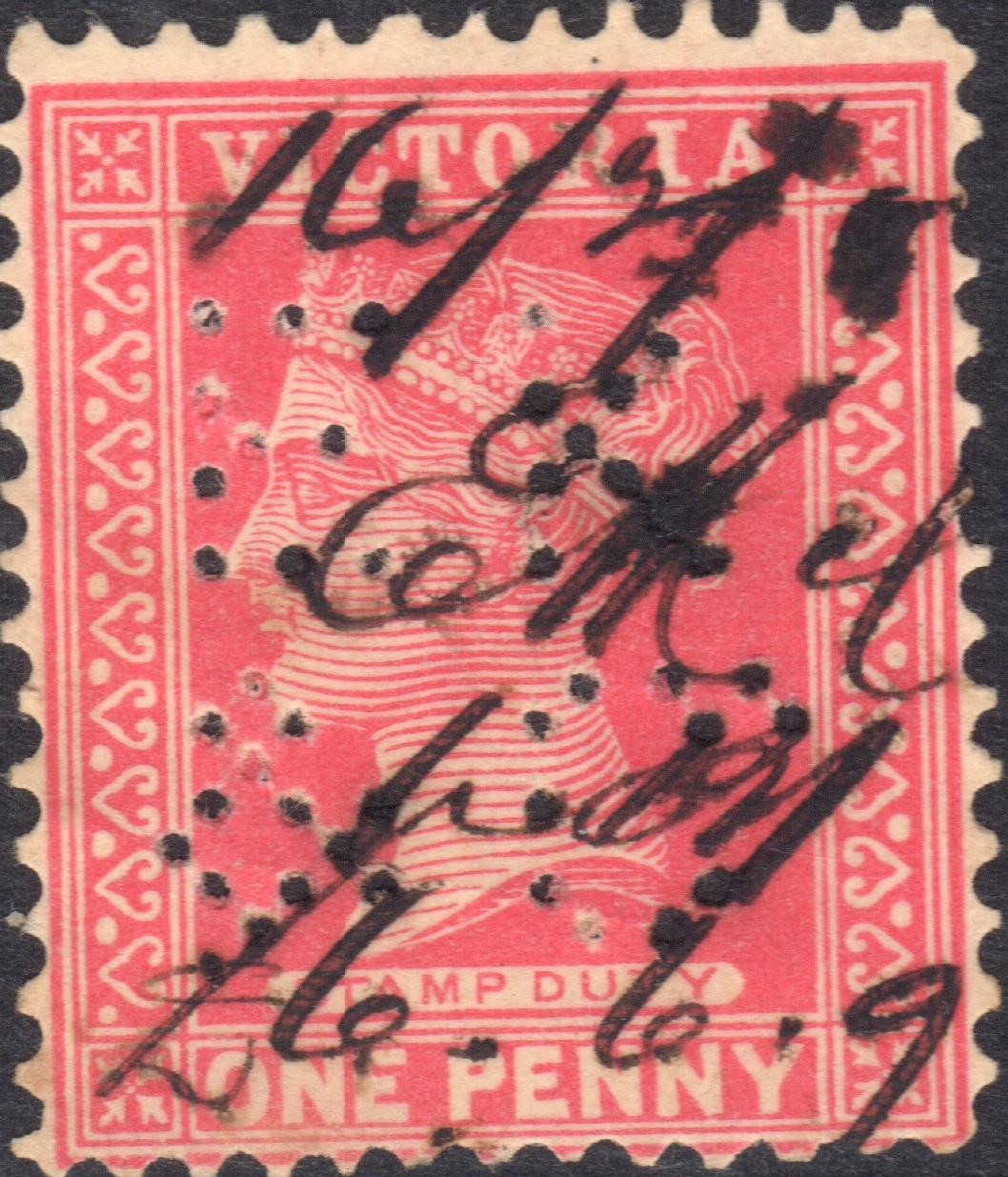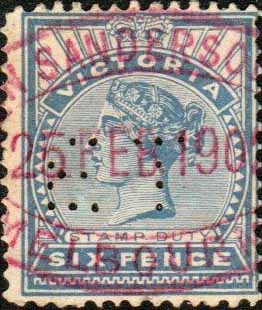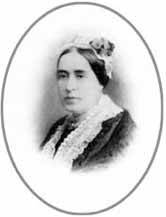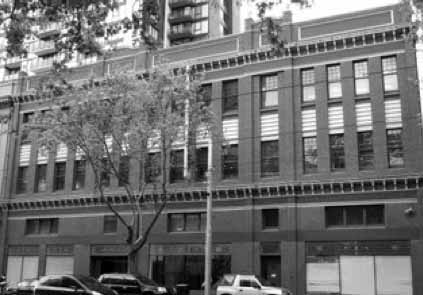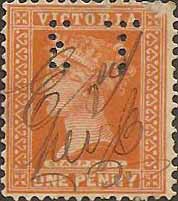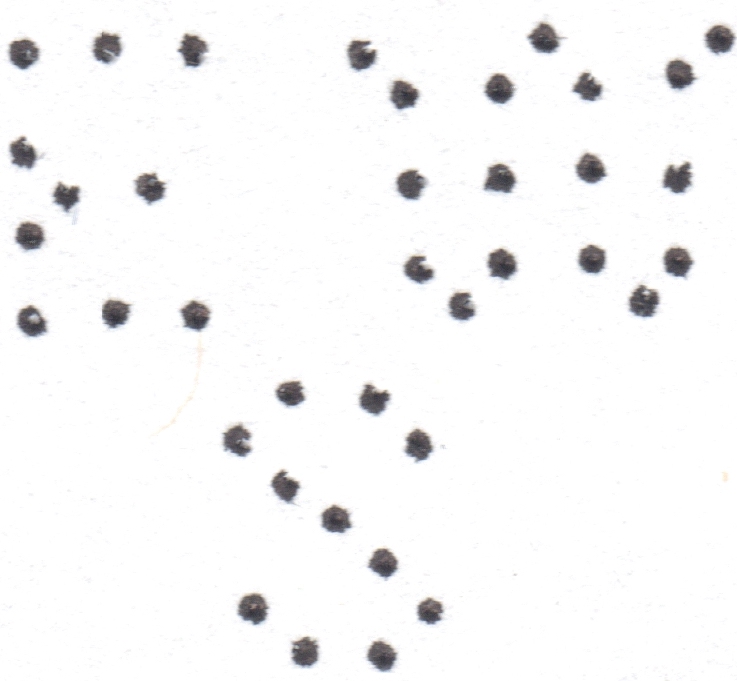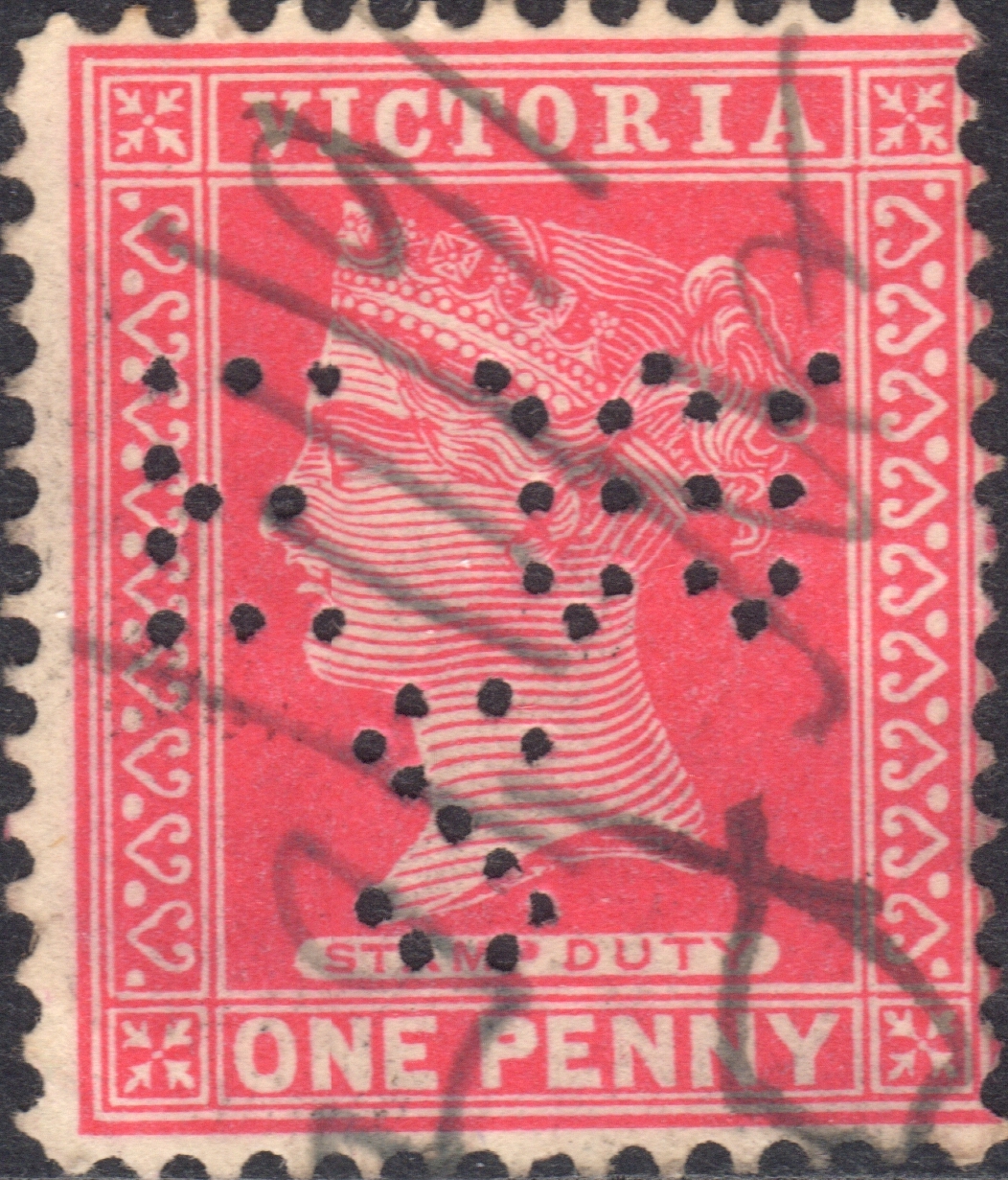|
Private Revenue Perfins of Victoria An Elsmore Coath production The authors would welcome your comments additions or input into this work A B C D E F G H I J K L M N O P Q R S T U V W Y Other E -------------------------------------------------------- EB.a
User: Edgar Bell & Co(unconfirmed) Customs Agents Address: 14-16 Market St, Melbourne, VIC Revenue Use: 1911 Series 1d Rarity Scale:
1911 Series 1d R4
Background: Edgar Bell & Co was established in Melbourne in 1888 as Customs House, Shipping and Forwarding company. The company was initially run by brothers Edgar and Henry Bell. Henry later moved to work at competitor, Howard Smith and Co. Little is reported about the company, except their location in Market Street. Edgar Bell & Co merged with fellow Customs and Shipping Agents C Stokes & Co (formed 1899) in 2004 to form Stokes and Bell Pty Ltd.
14-16 Market St, Melbourne, VIC Device: The EB.a pattern is not proved to Edgar Bell via use on postage stamps but it can be linked to the company by its use on revenue stamps.
Note in the examples for EB.b one shows part of a “Received by” cancelation that shows the words “…DGAR BELL & CO”. This leaves the E of Edgar unconfirmed but the other example shows a manuscript cancel that is “EB&Co”. Given that these revenue stamps both share the same EB pattern it is reasonable to assume that the user is Edgar Bell & Co.
EB.a and EB.b are both Temporary perfin patterns made by a Stamp Vendor and would have been in a single die format. They share the same basic layout but differ in scale. This is sufficient to regard them as both being used by Edgar Bell & Co as the Stamp Vendors who provided perforating services have been shown to be careful in the structuring of patterns for a specific user.
EB.a was used in about 1902 and there are various layouts of the pattern showing different separation of the letters and in some instances misplaced pins but only the EB.a as shown has been found on revenue stamps.
EB.b was used from about 1904 until at least 1922. As with EB.a, EB.b was subject to much variation in settings and you will note that the examples shown under EB.b show different separation between the letters. This is common in Temporary patterns, as different settings of the same letter combinations made up over the period of usage of the pattern will vary.
Both EB.a and EB.b are found used on the postage and revenue stamps of Victoria and EB.b is also later found used on the postage stamps of Australia from 1913.
Patterns: Refer to other Edgar Bell & Co patterns in: VIC: EB.b -------------------------------------------------------- EB.b
User: Edgar Bell & Co(unconfirmed) Customs Agents Address: 14-16 Market St, Melbourne, VIC Revenue Use: 1911 Series 1d, 6d 1915 Series 2d Rarity Scale:
1911 Series 1d R4, 6d R4
1915 Series 2d R4
Background: See EB.a Device: See EB.a Related Patterns: Refer to other Edgar Bell & Co patterns in: VIC: EB.a -------------------------------------------------------- EK/&Co.a
User: Edward Keep & Co Wholesale
Importers & Iron Mongers Address: 37 Elizabeth St, Melbourne, VIC Revenue Use: 1886-1899 Series, inscribed 'STAMP DUTY' 1d (shades) Rarity Scale:
1886-1899 Series 1d R4 Background: Device: Single Die Related Patterns: See EK&Co.b --------------------------------------------------------
EK/&Co.b
User: Edward Keep & Co Wholesale
Importers & Iron Mongers Address: 37 Elizabeth St, Melbourne, VIC Revenue Use: 1886-1899 Series, inscribed 'STAMP DUTY' 1d (shades) Rarity Scale:
1886-1899 Series 1d R4 Background: Device: Single Die Related
Patterns: See EK&Co.a -------------------------------------------------------- ET.a
User: Eliza Tinsley Iron and Steel, later Machinery Merchants Address: 46, 48, 50, 52 King St, Melbourne, VIC From 1901 640-652 Bourke St, Melbourne, VICRevenue Use: 1886-1899 Series, inscribed 'STAMP DUTY' 6d Rarity Scale:
1886-1899 Series 6d R4
Background: *The company that would become Eliza Tinsley started in 1851 at Cradley Heath in ‘Black Country’ area of the Western Midlands in England. During the Industrial Revolution this area was one of the most industrialised parts of Britain with coalmines, coking, iron foundries and steel mills doting the area.
It was in the centre of this thriving, industrialised area that Eliza Tinsley started her chain making business in the mid 19th Century. Eliza was married to Thomas, a self-employed nail maker. They had six children and following the death of their eldest daughter and Thomas in 1851, Eliza continued to run the business under her own name and it soon became very successful.
Eliza was know locally as “The Widow” and for over 20 years built her reputation as a fair and knowledgeable business woman visiting customers in the United Kingdom and even sending a representative out to Melbourne, to establish a company in her name there.
By 1871 Eliza Tinsley in England was employing about 4000 people and production included wrought iron nails, rivets, chains, chain cables and anchors. Many of these employees were “outworkers”, who lived locally and visited the company’s site once a week to collect materials and then returned the next with finished products. Chain making was incredibly labour intensive and the heat, dirt and strength involved resulted in a very male dominated industry – making Eliza’s success even more of an achievement.
Eliza retired in 1872 at 58 and died in 1882 at home. The business was taken over by four partners including G Harry Green, a former sales representative of the Company. He eventually bought out the other partners but the Tinsley family continued to work in the company and in 2014 a 5th generation of the Tinsley family still remained closely linked with the business.
In the later part of the 1800’s and early 1900’s increased automation in manufacturing meant that the company moved away from nail production and expanding chain manufacturing in support of the booming industries of ship building and mining.
The company expanded through the 20th Century with acquisitions of the Swindell Tool Company (1928) J T Parkes - door and gate products (1966), Wiggin Chains - welded chain manufacturer (1984) and J H Carter - un-welded chain manufacturer (1994). By 1994 the companies chain and accessory range dominating the UK market. In 2006 Eliza Tinsley was acquired by an Indian based Manufacturing Group.
The details of Eliza Tinsley’s opera\tions in Melbourne are somewhat unclear. Eliza’s sonsCharles Theophylus Tinsley, (Born 1844) and his brother Thomas Tinsley (Born 1846) are both known to have immigrated to Australia. The approximate dates are 1861 for Charles and 1871 for Thomas. Given the family nature of the company at this early stage it is most likely that Charles and/or Thomas, or indeed both, were involved in the establishment of the branch of the company in Melbourne.
Newspaper records show that on 1 May 1891 Eliza Tinsley announced that the company in Melbourne described as “Iron, steel, and hardware merchants, at 46 King-street, Melbourne, under the style of " Eliza Tinsley,"” which had been conducted by Charles Theophilus Tinsley, and Frank Evers, would be transferred to Charles Theophilus Tinsley, and Leonard Richard Lloyd. Further it was agreed that the business will be continue, “at the premises above mentioned under the same style of “Eliza Tinsley”.
Charles Theophylus Tinsley, died in Melbourne in 1900 but the company moved into new premises at 640-652 Bourke St in 1901 with the occupants being the firms of Eliza Tinsley, (hardware importers), and Lloyd Bros, and James Maginnis, (leather merchants).
The Bourke St building was extended to its current form in 1925 and the company continued to operate from these premises until the 1970s, after this time it was used for hardware storage (warehousing) and later sold to Australia Post who used it as storage purposes.
Eliza Tinsley Building 640-652 Bourke St, Melbourne Device: The ET.a pattern is proved to Eliza Tinsley via its use on postage stamps.
There are a total approximately 30 ET patterns found on the postage stamps of Victoria and Australia from the period 1896 until 1940, yet only two ET’s have been found used on a revenue.
Most of the various ET patterns are Temporary perfin patterns made by a Stamp Vendor but the company did purchase its own Customized perforator in 1920 but the pattern from this device is not found on revenue stamps.
The ET.a pattern is found used on the postage and revenue stamps of Victoria in the period in the period 1894 until 1902.
These Temporary patterns can be subject to variation in terms of the distance between the letters in the various settings. There are only 2 known settings of this pattern but only this setting is recorded on revenue stamps. In the other setting the letters are slightly closer together.
Related Patterns: Refer to other Eliza Tinsley patterns in: VIC: ET.b *Eliza Tinsley web site Trove Walking Melbourne -------------------------------------------------------- ET.b
User: Eliza Tinsley Iron and Steel, later Machinery Merchants Address: 46, 48, 50, 52 King St, Melbourne, VIC From 1901 640-652 Bourke St, Melbourne, VICRevenue Use: 1886-1899 Series, inscribed 'STAMP DUTY' 1d (shades) Rarity Scale:
1886-1899 Series 1d R4 Background: See ET.a above Device: The ET.b pattern is proved to Eliza Tinsley via its use on postage stamps but the examples that we have seen of the pattern used on revenue stamps show partial impressions of the words Eliza Tinsley in manuscript cancels.
There are a total of approximately 30 ET patterns found on the postage stamps of Victoria and Australia from the period 1896 until 1940, yet only two ET’s has been found used on a revenue.
Most of the various ET patterns are Temporary perfin patterns made by a Stamp Vendor but the company did purchase its own Customized perforator in 1920 but the pattern from this device is not found on revenue stamps.
The ET.b pattern is found used on the postage and revenue stamps of Victoria in the period in the period 1896 until 1903.
These Temporary patterns can be subject to variation in terms of the distance between the letters in the various settings. There are about 6 known settings of this pattern but most of these are only found on postage stamps.
Related Patterns: Refer to other Eliza Tinsley patterns in:
VIC: ET.a
-------------------------------------------------------- EWS.a
User: Edward Waters & Sons
Address: 87 King St, Melbourne, VIC Revenue Use: 1886-1899 Series, inscribed 'STAMP DUTY' 1d (shades) Rarity Scale:
1886-1899 Series 1d R4
Background: Edward Elijah Waters was born in London in September 1837, and began his career in a London lawyer’s office before migrated to Melbourne aboard the ‘Queen of the Seas’ in 1855.
He went first to Twofold Bay (Warrnambool) then a prosperous whaling station, before returning to Melbourne and joining a survey party, and then going mining at Ararat.
In February, 1859, Waters and Edwin Hart founded Hart and Waters, “patents agents” at 65 Little Collins Street, Melbourne and filed their first patent. In December, 1864, the partnership with Hart was dissolved with Waters carrying on the business alone as Edward Waters at 58 Little Collins Street.
By 1867, Waters was advertising as “International Patent Office, Patents obtained in Europe, America, India and Australian Colonies”; he was recognised as “the only practising Patent Law expert in the colonies”. Walter C. Hart (son of Edwin Hart) joined Edward Waters office as a boy of 12 in 1881; he remained with the firm for 65 years.
In early 1882, Waters opened a branch office in Sydney, with Fred Walsh as manager, at 6 Bridge Street. By June, 1884, the office had moved to 51 Hunter Street. (Walsh established his own patent services business in 1901.) By 1920, Edward Waters & Sons were at 67 Castlereagh Street, later moving to 11-13 Castlereagh Street in the 1930s.
In October, 1887, Waters opened a branch at 21 Queen Street, Brisbane, with C.E. Graham as manager.
Edward Waters’ office was at 87 Bourke Street, Melbourne, in 1887, but by 1890, Waters was located at St James’ Building, 131 William Street. When Waters’ son, Edward junior, was admitted into partnership on 30 March, 1895, and the firm became E. Waters & Son, they claimed to be responsible for half the patent business in Victoria and the adjoining colonies. Other sons joined the firm later.
In 1905, the firm re-located to the Royal Insurance Building at 414-418 Collins Street, where it remained until well into the 1940s. In mid 1949 E. Waters & Sons were incorporated into Hansen, Madden & Hendley of Temple Court, 422-428 Collins Street, Melbourne a watermark and intellectual property firm, now claim direct descent from Edward Waters business.
Edward Waters was the initiating force behind the Australian Institute of Patents Agents and its foundation president. He is considered the Father of the Patent Agents profession in Australia.
He was a Justice of the Peace, a director of The Australian Deposit & Mortgage Bank Ltd (1890), Chairman of the Albert Building Society (1889), Chairman of the Board of the Hawthorn Coffee Palace, President of the Lawn Tennis Association of Victoria for many years and Superintendent of Hawthorn Congregational Sunday School.
Edward Waters died on 22 December, 1917. Among those present at the funeral were Mr Justice Cussen, Henry Meeks, J.P. Derham, George Townsend Commissioner of Patents, and Graham Hart.
Device:
Related Patterns: Nil -------------------------------------------------------- A B C D E F G H I J K L M N O P Q R S T U V W Y Other © copyright 2011 |

